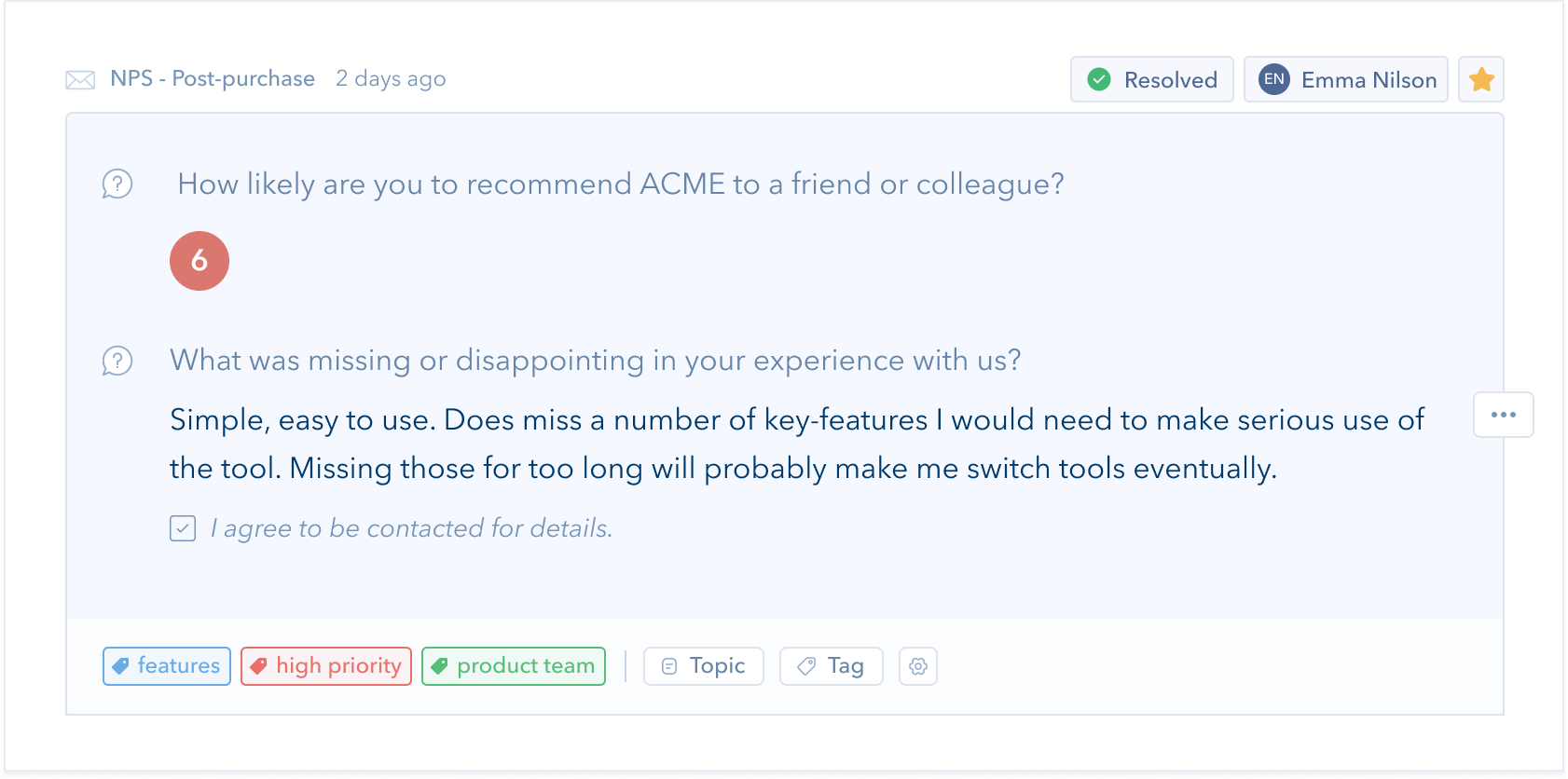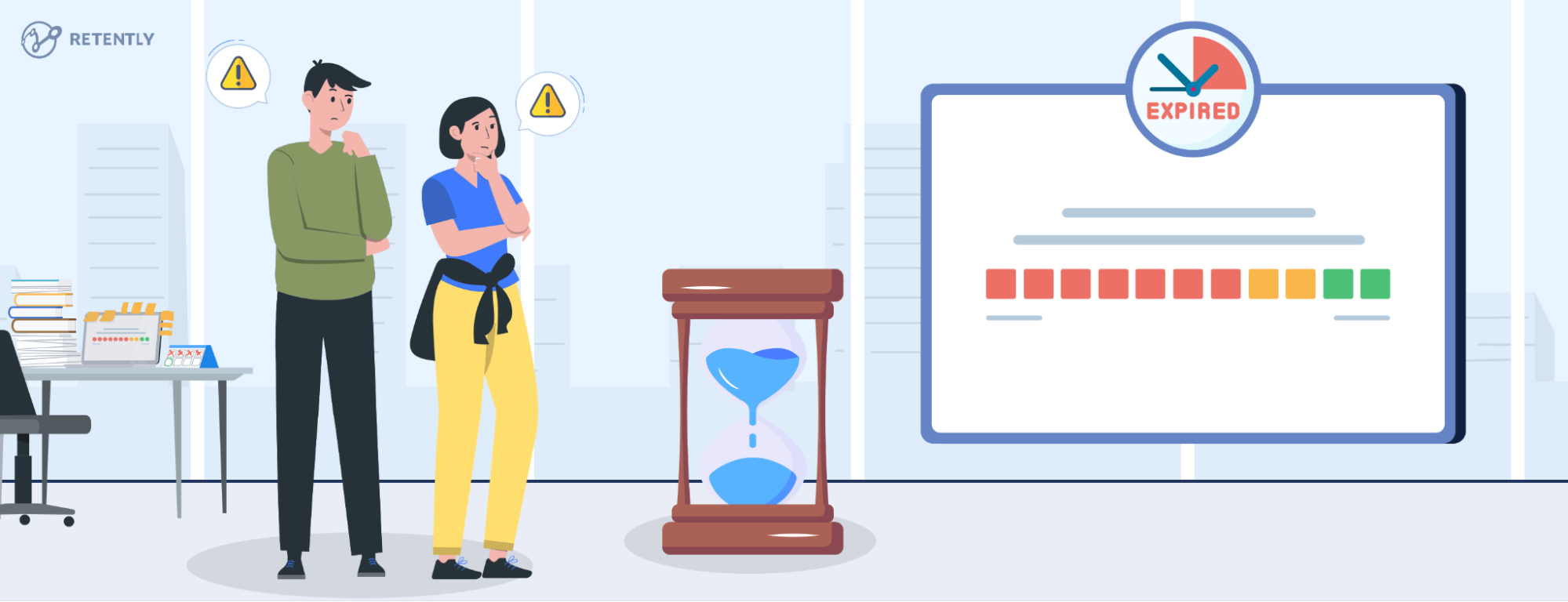One of the biggest benefits of Net Promoter Score® is that it gives you timely, relevant customer feedback when you need it most.
With this feedback, you can make changes and improvements to your product or service. Do it right, and there’s a chance you’ll win back an uncertain customer or earn the long-term respect and loyalty of a valuable client.
But when does feedback start to lose its relevance? Over time, your business and its customers will likely change. Can you still rely on feedback from months or years ago to guide your customer satisfaction priorities? Also, should you let it affect your Net Promoter Score?
In this post, we’ll look at how you should respond to feedback from your customers in both – short and long term. We’ll also discuss when you can safely delete or ignore customer feedback based on age.
To get the most from NPS, act as quickly as possible
People like to talk about simplicity as the biggest strength of the Net Promoter Score. After all, it’s a short survey that works precisely because it’s simple — an advantage with which longer, more detailed surveys can’t compete.
However, another strength of NPS® is the speed at which it lets you collect feedback from your users, customers, and clients.
Compared to traditional email or web-based surveys, which are designed to track satisfaction and sentiment in a macro sense, Net Promoter Score can track the response to an extremely current, short-term event.
For example, you can use NPS tools like Retently to survey your customers on new additions to your product, such as an updated design, new feature, or recent upgrade. Since NPS is designed for fast, meaningful feedback, getting your customers’ thoughts on a new functionality isn’t difficult.
This brings up an essential aspect of using Net Promoter Score effectively. If you leverage NPS to generate short-term, highly relevant feedback, you must act quickly to get the full benefits from the responses your customers provide.
This kind of feedback has huge short-term value, but it can also “expire” quickly. Act quickly, and you can produce real improvements while customers are paying attention, rather than weeks or months in the future when their interest level is lower.
After you close the loop, disconsider outdated responses
When you receive feedback from a Passive or Detractor with specific advice on how to improve your product or service, start working as soon as you can to address it and close the loop.
Then, once you’ve successfully implemented their recommendations (and closed the loop by following up for their response), disconsider their feedback from your actual NPS score.
Ignoring a specific NPS score given by your customers can feel like cheating, but in reality, it’s an intelligent move. After all, it makes very little sense (and provides very little value) to judge your business based on client or customer feedback that’s no longer relevant. However, there are situations when you might need that historical response later. Some products, including Retently NPS, give you the possibility to mark a score as ignored. It will not be considered when calculating your current overall NPS score, but you will still be able to access it later.
It’s also an important move for your customer relations on a micro level. If you’ve solved a major problem and turned a Detractor or Passive into a Promoter of your product or service, there’s no reason to keep their old score as a measure of their sentiment. Most NPS platforms will automatically update your general NPS score with a customer’s latest response, and you will no longer have to bother manually dismissing old responses.
Just remember to close the loop before you dismiss any customer score from your overall NPS. Overlooking genuine feedback before you have a chance to act on it distorts your Net Promoter Score. However, removing it from your NPS when it’s no longer relevant provides a more accurate and up-to-date reflection of your business.
Keep “big picture” feedback to inspire long-term change
Customer feedback can often be divided into two categories. There’s short-term feedback that discusses specific features, problems, and glitches, most of which can be fixed quickly by your team.
Then, there’s “big picture” feedback, which discusses issues and opportunities that can take weeks or months to solve or act on.
Big-picture feedback is harder to act on than short-term feedback — you won’t be able to close the loop within a day or two — but it can often be the most valuable feedback for helping you to make real, lasting changes to your business.
When you receive big-picture feedback from a customer — for example, a message about an extra feature you could implement or a complete redesign of your interface to solve usability problems — it’s never a good idea to disconsider it too early.
Instead, keep it on your dashboard so that you’re always aware of the feedback and ready to take action towards solving it. Only after you’ve closed the loop successfully should you think about ignoring from your NPS score the big picture, long-term feedback.
Few services, including Retently NPS, will allow you to sort customer feedback in theme buckets so it’s easier to filter them and close the feedback loop with all the responses from the same category.

Can the customer’s issue still be solved?
Here’s a simple way to check whether or not a customer’s feedback still belongs in your NPS dashboard. Ask yourself, “Is there still a solution to this issue? If so, can I implement it, or has it already been done?”
This simple question can tell you all you need to know about whether or not the feedback reporting an issue is worth paying attention to. If you’ve solved the problem, it’s time to dismiss it in your current NPS score. If the feedback refers to a problem that’s already been solved by another member of your team, it should be disconsidered.
As your user base grows, you’ll inevitably get feedback that’s irrelevant the moment you receive it. This type of feedback often comes from customers who stopped using your product long ago due to a fault that’s since been fixed without their knowledge.
If this is the case, close the loop by letting the customer know their problem has already been solved and point them toward the solution. After you close the loop, dismiss their feedback — it’s unfair to your business to let outdated feedback affect your current Net Promoter Score. Instead, send them another survey and see how their satisfaction level changed.
There is also a situation when a customer gives you a Detractor score but leaves before you have implemented a fix or solution for his trouble. Technically, you have closed the feedback loop, and your customer’s satisfaction should have increased. In reality, the customer who left will not receive another survey and hopefully give a better score. To address this situation, some NPS products provide a schedule to automatically mark a response as expired after a specific, configurable period of time, if that customer gives no new responses.
Risks of deleting or ignoring NPS responses
Now that we’ve covered when an NPS response expires and is no longer relevant, there’s one more thing to be discussed: What are the risks of ignoring NPS responses?
We advise against deleting responses unless they are test scores and feedback you have given yourself while getting familiar with an NPS product.
The thing is that even a score that appears to be irrelevant at the beginning still points out an issue you should take care of. For instance, some customers will give you a low score, saying they have no idea why they’re receiving it. Most likely, those customers tried your product a long time ago and forgot about it since. That’s a sign that you should consider reviewing your customer list and removing customers who should not receive recurring surveys. Fortunately, some NPS products will help you accomplish this task by tracking your customer’s status in your CRM or other applications and unsubscribing them from recurring surveys whenever they leave.
Other customers will give you a bad score and say they signed up by mistake, thinking that your company provides the solution they were looking for. Theoretically, this response is irrelevant. But in practice, this means that your landing copy might confuse or misinform your leads, so you might want to adjust it.
However, the best argument against deleting responses that have become irrelevant is that you will lose the historical data, or NPS trends as we call it, at Retently. We have already explained why the NPS score itself is irrelevant, but the dynamics of the score, whether it grows or drops, is crucial in assessing customer satisfaction over time.
That’s why you should consider ignoring an NPS response and make sure that you will always be able to re-add it to the NPS historical data when needed.
Manage your NPS feedback with Retently NPS
Now that we’ve dived deep into the dynamics of NPS responses and their time-sensitive nature, it might be a good time to reflect on your own NPS practices. Think about it – are you holding onto feedback that has lost relevance? Have some of your NPS responses expired, no longer reflecting the current state of your customer satisfaction? It’s time to dust off and reevaluate.
Retently makes it easy to survey your customers and get actionable, valuable feedback using Net Promoter Score. You can manually remove irrelevant responses or schedule to automatically expire feedback from customers who left, without affecting your current NPS score.
Your brand’s growth depends on your ability to stay in tune with your audience and act on timely, relevant insights. Create your free Retently account here, and let’s get to work.






























 Alex Bitca
Alex Bitca 

 Greg Raileanu
Greg Raileanu 


 Christina Sol
Christina Sol 